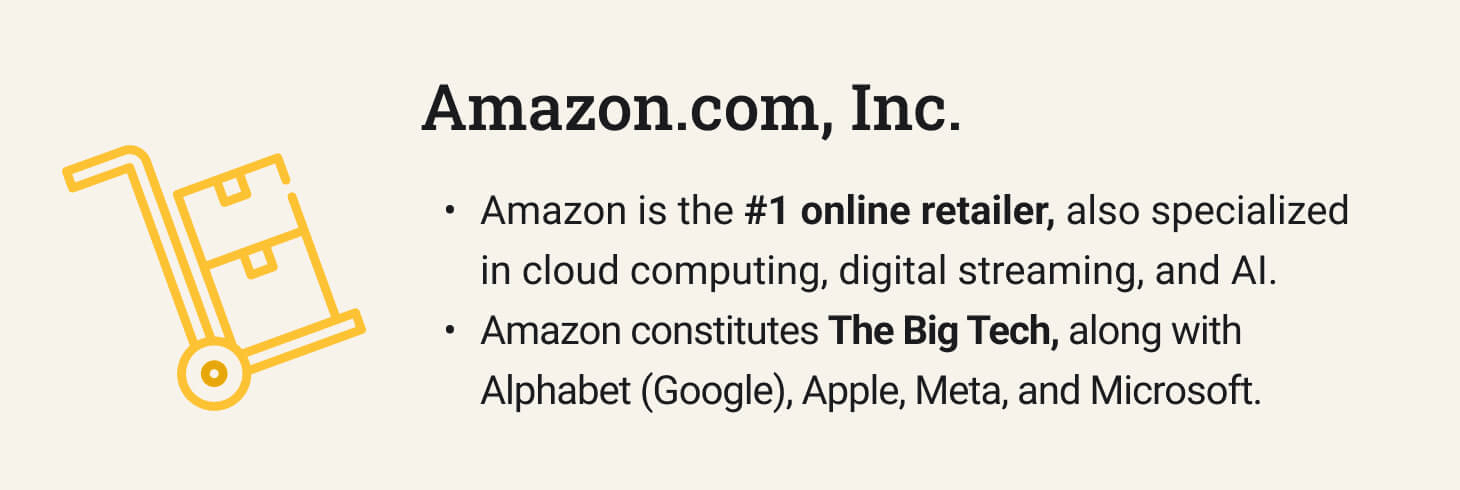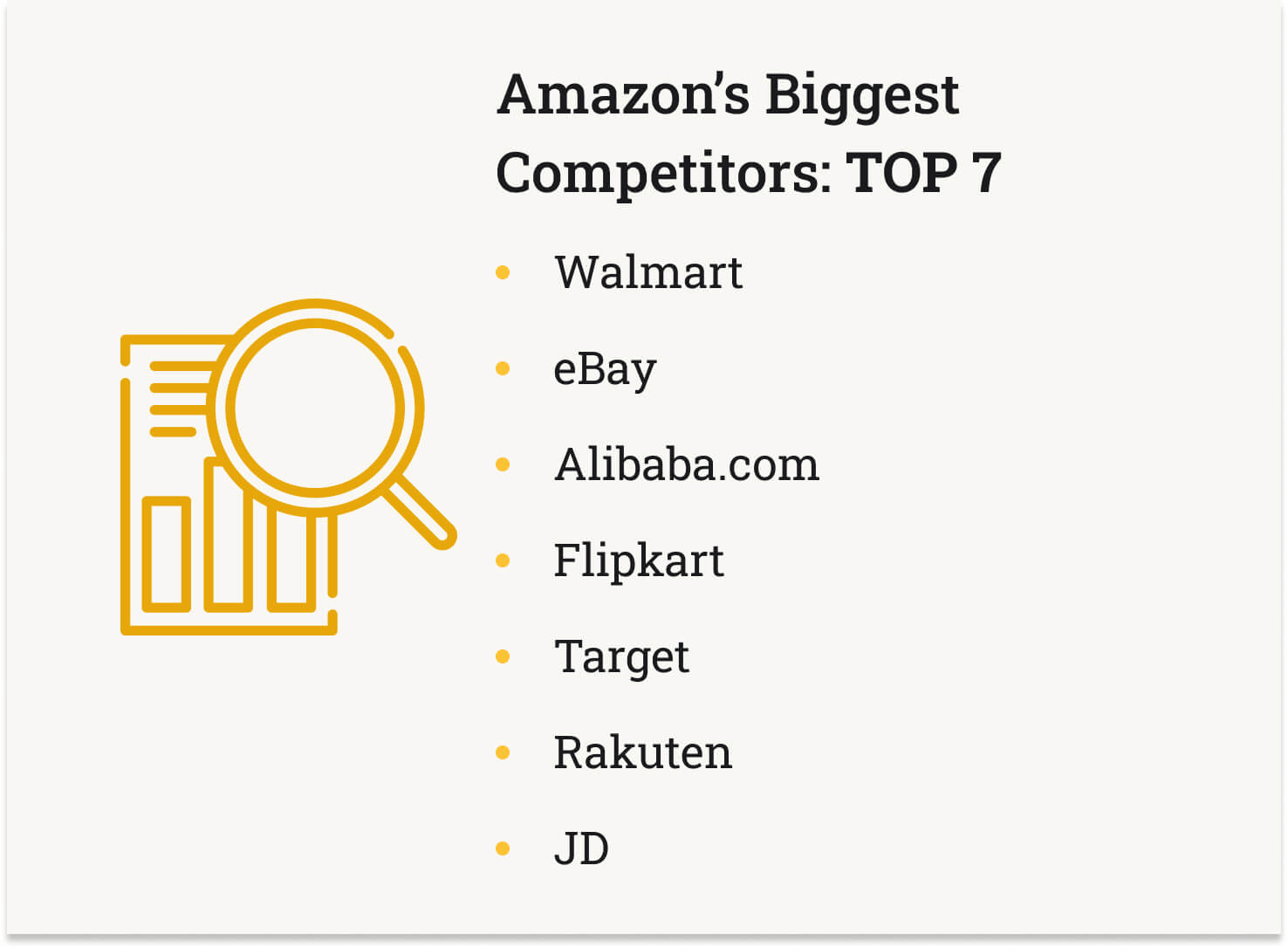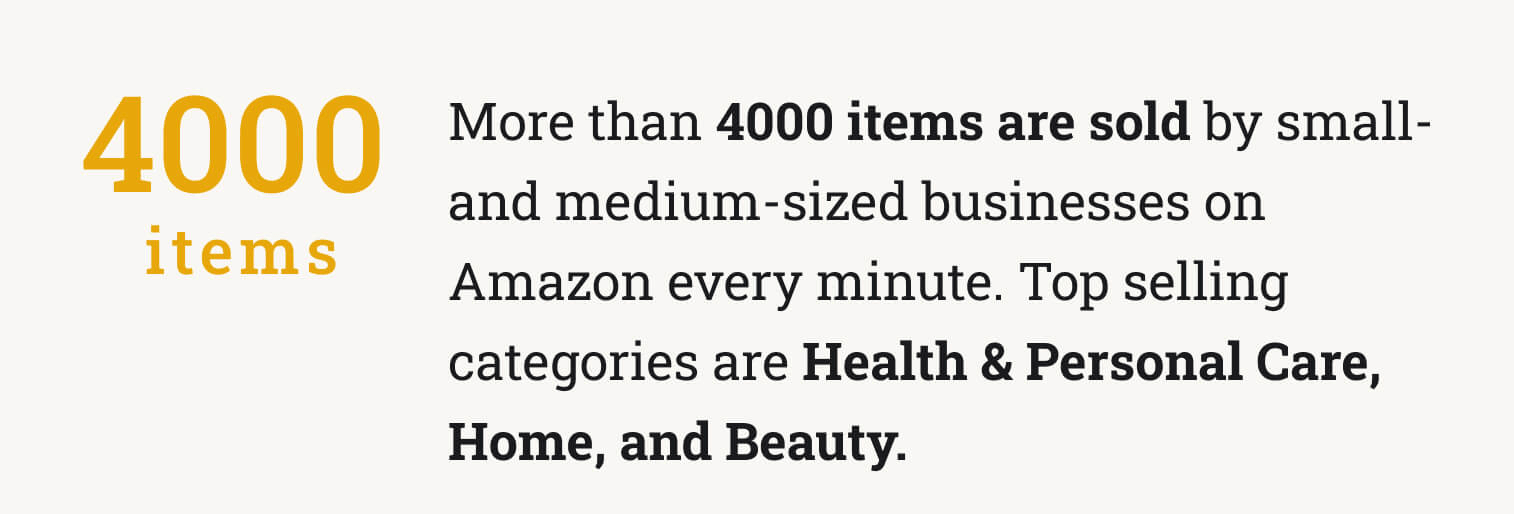
In 1994 Jeff Bezos quit his job and launched a new company in his garage. Nowadays, we know this company as Amazon, the world’s largest online retailer. Meanwhile, Jeff Bezos is the second-wealthiest person alive. There is a lot a student can learn from the Amazon case study, and we know where to start.
📚5 Things You Didn’t Know About Amazon
- Originally Amazon had only five most profitable products: compact discs, computer hardware and software, videos, and books. The site generated $20,000 per week in sales in the first month.
- When choosing a name, Bezos was looking through a dictionary. He chose “Amazon” because it was associated with something “exotic and different.”
- Amazon was an early competitor of Google when it started a project called Block View, with panoramic street views of neighborhoods.
- Amazon works on a futuristic delivery system, allowing customers to get their packages within 30 minutes using small drones.
- At the end of 2020, Amazon employed 1.271 million workers worldwide, more than Google and Meta combined.
💡 Best Ideas for an Amazon Case Study
Amazon is one of the largest online retailers in America, dealing with a wide range of consumer products. Various business factors affect Amazon’s performance. Here is the list of topics to consider for your Amazon case study.
- Amazon’s board of directors.
- Amazon’s corporate values and vision.
- Amazon’s significant partnerships.
- Logistic strategies in Amazon.
- Amazon’s bestselling products and services.
- Subsidiaries owned by Amazon.
- Amazon’s supply chain.
- Key marketing strategies of Amazon.
- Multi-level sales strategy in Amazon.
- Amazon’s financial strategy.
- The controversies around Amazon’s environmental impact.
- Working conditions in Amazon.
- Amazon’s response to the COVID-19 pandemic.
- Amazon’s web services.
- An overview of Amazon’s ecosystem.
🤝 Amazon Supply Chain Case Study #1
- Types of distribution facilities in Amazon.
Amazon started its distribution network in 1997 with two centers in Seattle and New Castle, Delaware. Nowadays, there are 75 fulfillment centers and 25 sortation centers. The various distribution facilities include:- Fulfillment and sortation centers,
- Delivery stations,
- Cross-dock centers,
- Prime now hubs,
- Air hubs.
- Amazon’s supply chain strategy.
Amazon’s supply chain strategy includes these four components:- Warehousing.
- Delivery.
- Technology.
- Manufacturing.
The expert warehousing and delivery strategies ensure that products are easily accessible from any country globally. At the same time, the company uses countless robotic solutions to pick and pack orders and store inventory.
- Amazon’s global supply chain.
Amazon operates eleven online marketplaces worldwide, allowing sellers to grow their business internationally and independently of where their business is physically located. When a company registers to sell its products on the Amazon marketplace, they gain immediate access to customers who trust the Amazon buying experience. - Employees working for Amazon’s supply chain.
Over 125,000 employees work for Amazon’s distribution network. Employees are responsible for five basic tasks:- Unpacking and inspecting incoming goods.
- Placing goods in storage.
- Picking goods for an individual shipment.
- Packing orders.
- Shipping.

🌱 Amazon Sustainability Case Study #2
- Sustainable transportation in Amazon.
Transportation is a significant component of Amazon’s business operations and a crucial part of its plan to reach net-zero carbon by 2040. The company optimizes its transportation network through efficiency enhancements, technological innovations, and alternative solutions, allowing it to deliver packages more sustainably. - Amazon’s sustainable shopping initiatives.
In October 2021, Amazon provided its customers with more than 200,000+ climate-friendly products. The list includes health and household items, office products, and electronics. Climate-friendly products are labeled in shopping results and have additional sustainability information on their product pages. - Amazon devices are becoming more sustainable.
Amazon incorporates recycled plastics, fabrics, and metals into many new devices. In 2021, the company launched many new smart home devices and accessories, including up to 60% post-consumer recycled plastic and 100% post-consumer recycled fabric, depending on the product. - Diversity and inclusion in Amazon.
Amazon seriously takes its commitment to respect and value employees from all backgrounds, including gender, race, religion, sexual orientation, and disability. The company as well serves diverse customers and operates in various communities. The policies and procedures Amazon has for employees, selling partners, and customers focus on diversity and inclusion.
🛒 Walmart vs. Amazon Case Study #3
- Walmart vs. Amazon: size.
Before comparing the two retail giants, note that there is a difference between Walmart’s overall and e-commerce sales. Amazon currently controls nearly 38% of the United States e-commerce retail market, while Walmart only controls approximately 8% of the retail e-commerce market. However, it should be no surprise that Walmart’s physical locations vastly outnumber Amazon’s. - Walmart vs. Amazon: customers.
Walmart’s and Amazon’s customer demographics are nearly identical when viewed by generations or income levels. The only thing that differs is the average number of customers. Amazon has approximately 300 million customers worldwide, while Walmart (including physical stores) has 220 million customers. - Walmart vs. Amazon: marketing services.
Amazon and Walmart are very similar and set high standards for other retail companies regarding marketing. The difference is that Amazon has more options, which isn’t surprising since Amazon has been focused on e-commerce for 25 years. - Walmart vs. Amazon: member benefits.
Both Walmart and Amazon have premium subscriptions that bring shopping to a new level. These subscriptions give customers access to perks and benefits, for example, one-day shipping of products. This ongoing competition between the two commercial giants allows meeting their current customers’ demands and expectations more efficiently.

📱 Amazon Fire Phone Failure Case Study #4
- The Amazon Fire Phone origin.
The Fire Phone is a smartphone developed by Amazon and manufactured in 2014. At first glance, the phone runs Amazon’s Fire OS, which is a slightly different version of Android without the Google apps or the Play Store. One of the phone’s most distinctive features is the five front-facing cameras. Those cameras detect hand gestures, which makes it possible to navigate the phone without touching it. - The Amazon Fire Phone promise.
The original Amazon idea was to create a 3-D display visible from multiple angles. The company ended up only with facial recognition, which allowed the phone’s cameras to track a user’s gaze and adjust the 3-D effect with background images. Unfortunately for Jeff Bezos, customers didn’t find any practical applications for 3-D lock screens. - The Amazon Fire Phone failure.
When Fire Phone was released, Amazon customers couldn’t afford a $650 smartphone. That was even more expensive than the price of the iPhone 6, released that same year. Pre-orders of the iPhone 6 exceeded four million units within 24 hours of availability, setting a record for Apple and high competition for Amazon. Soon, it became apparent that the Fire Phone had failed to appeal to Amazon’s customers, and there was no genuine interest in this innovation.
🧑 Amazon Crisis Management Case Study #5
- How Amazon managed the coronavirus crisis.
Facing empty store shelves during the pandemic, shoppers turned to Amazon for needed products. The company had to spend billions of dollars on coronavirus-related investments like employee safety gear. Amazon also hired 36,400 people in the first three months of the pandemic to fulfill all the customer orders. CEO Jeff Bezos acknowledged that was the most challenging time the company had ever faced, but Amazon could handle this crisis. - Amazon’s environmental impact.
In 2019, Amazon released a report with details on the company’s impact on the environment. That year, the company emitted 44.4 million metric tons of carbon dioxide into the atmosphere, almost equal to Norway’s annual emissions. Amazon created the Climate Pledge program to save its brand image and promised to achieve net-zero carbon emissions by 2040. - Amazon’s clashes with labor.
In 2021, one of Amazon’s employees started a discussion on Twitter, saying that its workers do not even have time to visit a bathroom in their workplace. Referring to the multiple reports alleging poor working conditions at the company, Amazon insists that all the accusations were false. Otherwise, people would not have been joining Amazon’s workforce.
🔥 40 Hot Titles for an Amazon Business Case Study
- Customer service in Amazon company.
- Performance evaluation of Amazon company.
- Amazon.com’s information systems.
- Transportation and logistics department in Amazon.
- Amazon company’s strategy and customization.
- Advantages and disadvantages of Amazon company.
- Amazon’s sales and marketing strategies.
- Amazon company’s supply chain management.
- Amazon.com company’s e-commerce.
- Organization and leadership in Amazon company.
- Amazon vs. Walmart: giants of the retail industry.
- Amazon company’s success factors.
- Amazon and Yahoo companies’ differences.
- The competitive influence of Amazon company.
- Apple vs. Amazon: companies’ success.
- Amazon and eBay: e-business applications.
- Local and global markets of Amazon company.
- Principles of team management at Amazon.
- Cybersecurity measures for Amazon Web Services.
- Corporate valuation of Amazon.com.
- Amazon’s innovation and sustainability.
- Amazon’s e-business model.
- The Amazon effect and the future of retail business.
- History of Amazon’s development.
- Consumer perception of Amazon.
- Strategic marketing at Amazon.
- Amazon’s distribution systems in the United States.
- Amazon Company’s marketing management.
- Security measures for Amazon.com.
- Competitive strategies of Amazon.com.
- Amazon: vision, mission, and strategy.
- The strengths and weaknesses of the Amazon company.
- How does Amazon diversify its business processes?
- Working conditions in Amazon company.
- Evolution of Amazon’s business model.
- Comparison of Google and Amazon leadership styles.
- Amazon Company’s logistics operations.
- Jeff Bezos’s leadership and the Amazon revolution.
- E-Reader market dominance of Amazon.
- Amazon company’s collaborators and competitors.
🔗References
- Top online stores in the United States in 2022, by e-commerce net sales – statista
- Supply Chain – Amazon Sustainability
- Amazon’s Policy Positions
- eCommerce Sales & Size Forecast – trade
- Amazon’s Environmental Impact Delivers Climate Change Concerns | Supply Chain Transportation and Logistics Center at the University of Washington